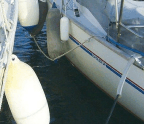THE UK’S 11 FIERCEST TIDE RACES
DAG PIKE has spent 65 years at sea on yachts and motor boats, and has made several transatlantic record attempts



The British Isles lies in one of the most turbulent maritime regions in the world. Not only are our shores battered by the depressions that roll in with frequent monotony during the winter months, but every 12 hours the tide turns and billions of litres of water move in and out from our shores. This huge water flow fills and empties the English Channel, pours up into the Irish Sea and on up and down the West Coast of Scotland and up north it finds a way around the islands to enter the North Sea.
The tidal streams generated by this flow can be fearsome, running up to 10 knots in places and when the land gets in the way, impeding the flow of the tide, tide races can generate wild seas that can prove a significant hazard for sailing yachts, with short steep waves, where you can barely recover from one wave before the next one hits you. In benign conditions this need hardly trouble you. Where the seabed rises suddenly, tidal flows are concentrated around headlands or through narrows, and if the tide and wind are opposed, then swell with a long wavelength in open water will slow down and concertina up, making the waves build in height, with much steeper faces, crests that are much more likely to break and with the ability to swallow boats whole. You don’t want to get it wrong.
TACKLING A FEARSOME RACE
Of course the simple answer is to avoid tide races altogether but around our uneven coast, this can be wildly impractical with detours of many miles and hours, or long delays to await better conditions. Many tide races have earned a fearsome reputation, and not without reason, but once you know and understand them there can often be a way through, either at particular times and states of the tide, in certain conditions, through channels of calmer water, or by enduring a bit of uncomfortable sailing. You can usually find the areas where tide races occur by reading the pilot guides or they can be marked on the charts so you can prepare for them but a word of caution here. Don’t follow their guidance blindly. Firstly, think very carefully about going through a tide race at night. It can be hard to assess the conditions ahead and often the best route may be close under a headland inshore where you need good visibility to steer
You’re reading a preview, subscribe to read more.
Start your free 30 days





